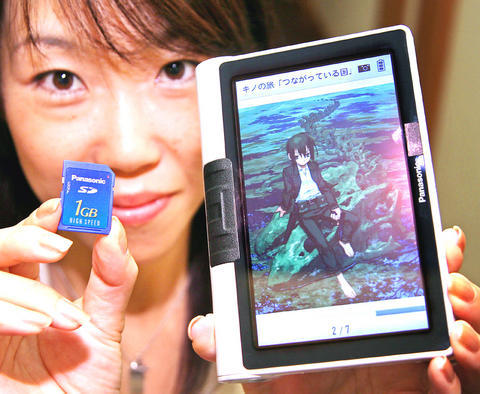If you are selling ebooks, I'm a hard sell. For one thing, my enthusiasm for traditional books is just this side of pervy. I live among mountains of them and always have, among the most beautiful mass-produced objects of all time. Some of my most treasured possessions are broken-backed, scribbled-in, jacketless books first read when a teenager; they've lasted longer than merely human friends. When I eventually become a nasty-minded, dribbling old man I'm sure I will be found creeping round second-hand bookshops, sniffing the produce, snuffling with pleasure.
If, that is, the bookshops are still there, and have not been put out of business by ebooks -- digital versions that can be read on computers or hand-held devices. But I'm a sceptic. A very long time ago, 10 years or more, I vividly remember being at Davos for the rich-or-clever people's annual frolic in the snow, and being assured that epaper -- "electronic paper" -- was about to transform the way we read.
So why the tortoise progress of the ebook?

PHOTO: AFP
It's partly that traditional books are such good technology. They are a little larger than the hand, extremely portable, nice to hold and look at and remarkably cheap. Yes, there is an environmental issue but most are made of cheap, sustainable woodpulp. Simple technology that works is unlikely to go out of fashion.
Beyond that, most ebook readers simply aren't good enough, whether they're dedicated devices or the multi-purpose palmtop computers made by the likes of Palm and Hewlett-Packard. They're fine to use for an hour or two when you are sitting upright in even indoor light, but they're pretty useless when you are traveling, sitting in the garden or slumped in the bath. The ebook reader that is as easy on the eye as a real book, and as quick to flick through, and as portable, hasn't arrived.
Or perhaps it has. Enter Sony's Reader and iRex's Iliad, which are being touted as the first really useable, easy-to-read products. I've had an Iliad for a month to try out. It costs ?449 (US$890) plus VAT, or slightly more with a handsome leather case that makes it look like a slightly larger, thinner Filofax.
It is meant to be read, at length, and its claim is that the screen is good enough to allow you to read, even a Tolstoy, even in sunlight, and actually enjoy the experience. It works with a basic menu, four buttons separated into news (of which more anon), books, docs and notes. There is a small pen-like stylus attached to the back, which lets you make notes or add comments to your documents and -- the best innovation -- a thin silver bar on the left of the screen that you flick with your thumb to turn the pages.
It is charged, like a laptop, mobile or any other similar device, and the battery should see easily you through a day's reading and writing. For those interested in detailed specifications, I can say it weighs about the same as a medium-sized banana. It powers up quickly and turns off easily.
Here is the first crucial thing: the screen does work. By "work", I mean that the words stand out clearly without shimmering, and that you can certainly read it outside, in dappled light and direct sunlight, as you would not be able to read a normal computer screen. The effect is matt, not shiny, and black-and-white, not color.
What about page-turning? It is slower than a book. There is a distinct "one-and-two" count as the page dissolves and re-forms after your thumb has touched the flicker, and it can be disconcerting. I found it more cumbersome than turning a page. Speeding this up will be important if the ebook is to really catch on. There is a scroll-bar on the bottom of the page, and with the stylus you can jump to different parts of the book, but again this is slower than the real thing, and obviously you can't turn over the corners of pages -- electronic bookmarks are, we're promised, on the way.
My advice to the makers is to refine the page-turning just a little more, offer a battered blue cloth-bound wallet and, above all, make it smell -- just a little musty, please. Or dank. You could offer a choice. But it's clear enough that after all the waiting and the over-hyping, the ebook is arriving. Before long you are going to see them being carried nonchalantly around. And after that some of you, at least, are going to buy one.

LIMITS: While China increases military pressure on Taiwan and expands its use of cognitive warfare, it is unwilling to target tech supply chains, the report said US and Taiwan military officials have warned that the Chinese People’s Liberation Army (PLA) could implement a blockade within “a matter of hours” and need only “minimal conversion time” prior to an attack on Taiwan, a report released on Tuesday by the US Senate’s China Economic and Security Review Commission said. “While there is no indication that China is planning an imminent attack, the United States and its allies and partners can no longer assume that a Taiwan contingency is a distant possibility for which they would have ample time to prepare,” it said. The commission made the comments in its annual

DETERMINATION: Beijing’s actions toward Tokyo have drawn international attention, but would likely bolster regional coordination and defense networks, the report said Japanese Prime Minister Sanae Takaichi’s administration is likely to prioritize security reforms and deterrence in the face of recent “hybrid” threats from China, the National Security Bureau (NSB) said. The bureau made the assessment in a written report to the Legislative Yuan ahead of an oral report and questions-and-answers session at the legislature’s Foreign Affairs and National Defense Committee tomorrow. The key points of Japan’s security reforms would be to reinforce security cooperation with the US, including enhancing defense deployment in the first island chain, pushing forward the integrated command and operations of the Japan Self-Defense Forces and US Forces Japan, as

IN THE NATIONAL INTEREST: Deputy Minister of Foreign Affairs Francois Wu said the strengthening of military facilities would help to maintain security in the Taiwan Strait Japanese Minister of Defense Shinjiro Koizumi, visiting a military base close to Taiwan, said plans to deploy missiles to the post would move forward as tensions smolder between Tokyo and Beijing. “The deployment can help lower the chance of an armed attack on our country,” Koizumi told reporters on Sunday as he wrapped up his first trip to the base on the southern Japanese island of Yonaguni. “The view that it will heighten regional tensions is not accurate.” Former Japanese minister of defense Gen Nakatani in January said that Tokyo wanted to base Type 03 Chu-SAM missiles on Yonaguni, but little progress

NO CHANGES: A Japanese spokesperson said that Tokyo remains consistent and open for dialogue, while Beijing has canceled diplomatic engagements A Japanese official blasted China’s claims that Japanese Prime Minister Sanae Takaichi has altered Japan’s position on a Taiwan crisis as “entirely baseless,” calling for more dialogue to stop ties between Asia’s top economies from spiraling. China vowed to take resolute self-defense against Japan if it “dared to intervene militarily in the Taiwan Strait” in a letter delivered Friday to the UN. “I’m aware of this letter,” said Maki Kobayashi, a senior Japanese government spokeswoman. “The claim our country has altered its position is entirely baseless,” she said on the sidelines of the G20 summit in Johannesburg on Saturday. The Chinese Ministry